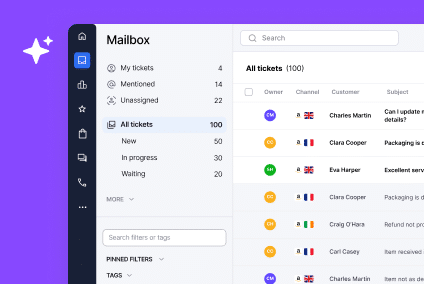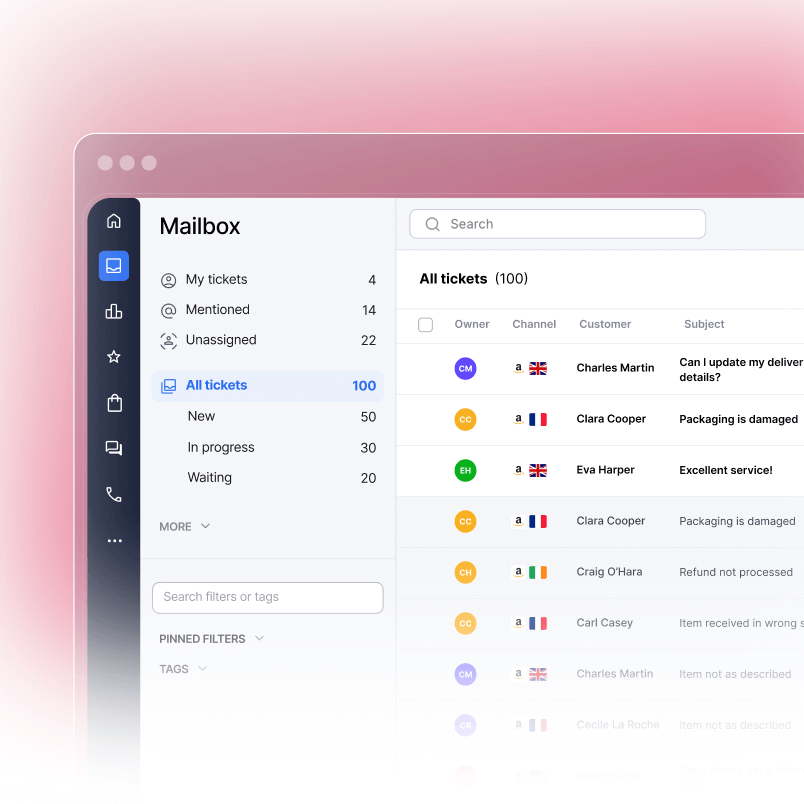What if you could know what your customers want before they even ask? And how exactly can Amazon automation tools predict customer needs with AI? Simple: Amazon automation tools with AI make this possible by analyzing customer behavior patterns and predicting their next moves. These smart systems help sellers anticipate buyer needs, automate responses, and create personalized shopping experiences that boost both satisfaction and sales.
As an Amazon seller, you’re probably dealing with hundreds of customer inquiries daily. The traditional reactive approach means waiting for problems to surface, then scrambling to fix them. But AI predicting customer behavior changes everything by shifting your strategy from reactive to proactive.
What Are Amazon Predictive Integrations?
Amazon predictive integrations are automated tools for Amazon sellers that use artificial intelligence to analyze customer data and forecast future behavior. These systems connect directly to your Amazon seller account and monitor everything from purchase patterns to browsing habits.
The technology works by processing massive amounts of data in real-time. Every click, search, and purchase creates a data point that feeds into machine learning algorithms. These algorithms identify patterns and make predictions about what customers will do next.
Core Components of Predictive Systems
Smart Amazon integrations typically include several key components:
- Data Collection Engines that gather customer interaction data
- Machine Learning Models that analyze patterns and make predictions
- Automation Rules that trigger specific actions based on predictions
- Performance Analytics that measure the accuracy of predictions
How Do Amazon Automation Tools Predict Customer Behavior?
The prediction process starts with data collection. Automated Amazon seller tools track multiple customer touchpoints including:
- Purchase History: What customers bought, when, and how frequently
- Browsing Patterns: Which products they viewed and for how long
- Search Queries: What terms they use to find products
- Cart Behavior: What they added but didn’t purchase
- Seasonal Trends: How their buying changes throughout the year
Machine Learning in Action
Amazon AI personalization uses several machine learning techniques:
Collaborative Filtering identifies customers with similar behaviors and predicts what one customer might want based on others’ actions. If Customer A and Customer B have purchased similar items in the past, the system might recommend products that Customer B bought to Customer A.
Content-Based Filtering analyzes product attributes and customer preferences to suggest relevant items. If a customer frequently buys organic skincare products, the system will prioritize showing them new organic skincare releases.
Sequence Modeling tracks the order of customer actions to predict next steps. This helps identify when someone is likely to make a purchase or when they might need customer support.
What Types of Predictive Support Can Amazon Sellers Use?
Product Recommendation Systems
Predictive eCommerce Amazon tools excel at suggesting the right products at the right time. These systems analyze customer behavior to determine:
- Which products complement previous purchases
- When customers are likely to reorder consumable items
- What seasonal items might interest specific customer segments
- Which new products align with established preferences
Proactive Customer Service
Instead of waiting for customers to contact you with problems, predictive systems identify issues before they escalate. Examples include:
- Shipping Delay Notifications: Alert customers about potential delays before they ask about their orders
- Quality Issue Prevention: Identify products with high return rates and proactively contact recent buyers
- Restock Reminders: Notify customers when frequently purchased items are running low
- Warranty Expiration Alerts: Remind customers about upcoming warranty deadlines
Inventory Demand Forecasting
Amazon predictive integrations help sellers maintain optimal inventory levels by predicting:
- Seasonal demand fluctuations
- Product lifecycle stages
- Market trend impacts
- Competitor influence on demand
This prevents both stockouts that lose sales and overstock that ties up capital.
How Do Smart Integrations Improve Customer Service Response Times?
Traditional customer service operates on a ticket-based system where customers submit inquiries and wait for responses. Smart integrations transform this approach by anticipating customer needs and providing instant solutions.
Automated Response Systems
When customers have common questions about shipping, returns, or product details, automated systems provide immediate answers. These systems use natural language processing to understand customer inquiries and match them with appropriate responses.
Priority Queue Management
Predictive tools identify which customer inquiries need immediate attention. High-value customers, urgent issues, and escalating problems get prioritized automatically, ensuring critical situations receive fast resolution.
Self-Service Options
AI systems predict what information customers need and make it easily accessible through:
- Dynamic FAQ sections that update based on common inquiries
- Chatbots that provide instant answers to routine questions
- Personalized help centers that show relevant articles based on customer history
Research shows that businesses using customer service automation can resolve queries faster while reducing operational costs.
What Benefits Do Automated Amazon Seller Tools Provide?
Increased Customer Satisfaction
Predictive customer service creates better experiences by:
- Solving problems before customers notice them
- Providing personalized product recommendations
- Reducing wait times for support responses
- Offering proactive communication about orders
Higher Sales Conversion Rates
Amazon anticipatory shopping increases sales through:
- Timely Product Suggestions: Showing relevant products when customers are most likely to buy
- Personalized Pricing: Offering discounts to price-sensitive customers at optimal moments
- Cart Recovery: Predicting when customers abandon carts and intervening with targeted offers
- Cross-selling Opportunities: Identifying complementary products that customers actually want
Operational Efficiency
Automation reduces manual work while improving accuracy:
- Customer service teams handle fewer routine inquiries
- Inventory management becomes more precise
- Marketing campaigns target the right customers at the right time
- Quality control improves through predictive issue identification
Competitive Advantage
Sellers using predictive tools gain significant advantages over competitors:
- Faster response to market changes
- Better customer relationships through proactive service
- More efficient resource allocation
- Higher customer lifetime value
How To Get Started with Amazon AI Personalization
Choose the Right Platform
Start with a comprehensive customer service platform that offers Amazon integration capabilities. Look for features like:
- Real-time data synchronization with Amazon
- Customizable automation rules
- Machine learning capabilities
- Detailed analytics and reporting
Implement Gradually
Begin with one or two automation areas rather than trying to implement everything at once:
- Start with Customer Service: Automate responses to common questions
- Add Product Recommendations: Implement basic suggestion algorithms
- Expand to Inventory: Use demand forecasting for better stock management
- Integrate Pricing: Add dynamic pricing based on demand and competition
Monitor and Optimize
Track key metrics to measure the success of your predictive systems:
- Customer satisfaction scores
- Response time improvements
- Sales conversion rate changes
- Support ticket reduction
- Inventory turnover improvements
Regular monitoring helps you identify which predictions are most accurate and where the system needs adjustment.
Amazon automation tools with predictive AI capabilities are transforming how sellers interact with customers and manage their businesses. These systems help you stay ahead of customer needs while reducing the manual work required to deliver exceptional service.
The sellers who embrace these technologies today will have significant advantages as the eCommerce landscape becomes increasingly competitive. Ready to transform your Amazon business with predictive automation? Try eDesk for free today and experience how AI-powered customer service can boost both efficiency and sales.
FAQs
How do Amazon automation tools predict customer behavior?
Amazon automation tools predict customer behavior by analyzing data from multiple sources including purchase history, browsing patterns, search queries, and seasonal trends. Machine learning algorithms process this data to identify patterns and forecast future customer actions.
What is Amazon anticipatory shopping?
Amazon anticipatory shopping uses AI to predict what customers will want to buy before they actively search for products. The system analyzes customer behavior patterns to suggest relevant products at optimal timing, increasing the likelihood of purchase.
How accurate are AI predictions for Amazon sellers?
AI prediction accuracy varies depending on the amount and quality of data available. Well-implemented systems typically achieve 70-85% accuracy for common predictions like demand forecasting and customer behavior patterns. Accuracy improves over time as the system learns from more data.
Do I need technical expertise to use automated Amazon seller tools?
Most modern automated Amazon seller tools feature user-friendly interfaces that don’t require coding knowledge. However, understanding your customer data and business metrics helps you configure the tools more effectively for optimal results.
How much do Amazon predictive integrations cost?
Costs vary depending on the platform and features you choose. Many providers offer scalable pricing that starts affordably for small sellers and grows with your business needs. The ROI typically justifies the investment through increased sales and reduced operational costs.
Can small Amazon sellers benefit from AI personalization?
Yes, small Amazon sellers can benefit significantly from AI personalization. Many tools offer entry-level plans designed for smaller businesses, and the efficiency gains from automation often provide immediate value regardless of business size.




